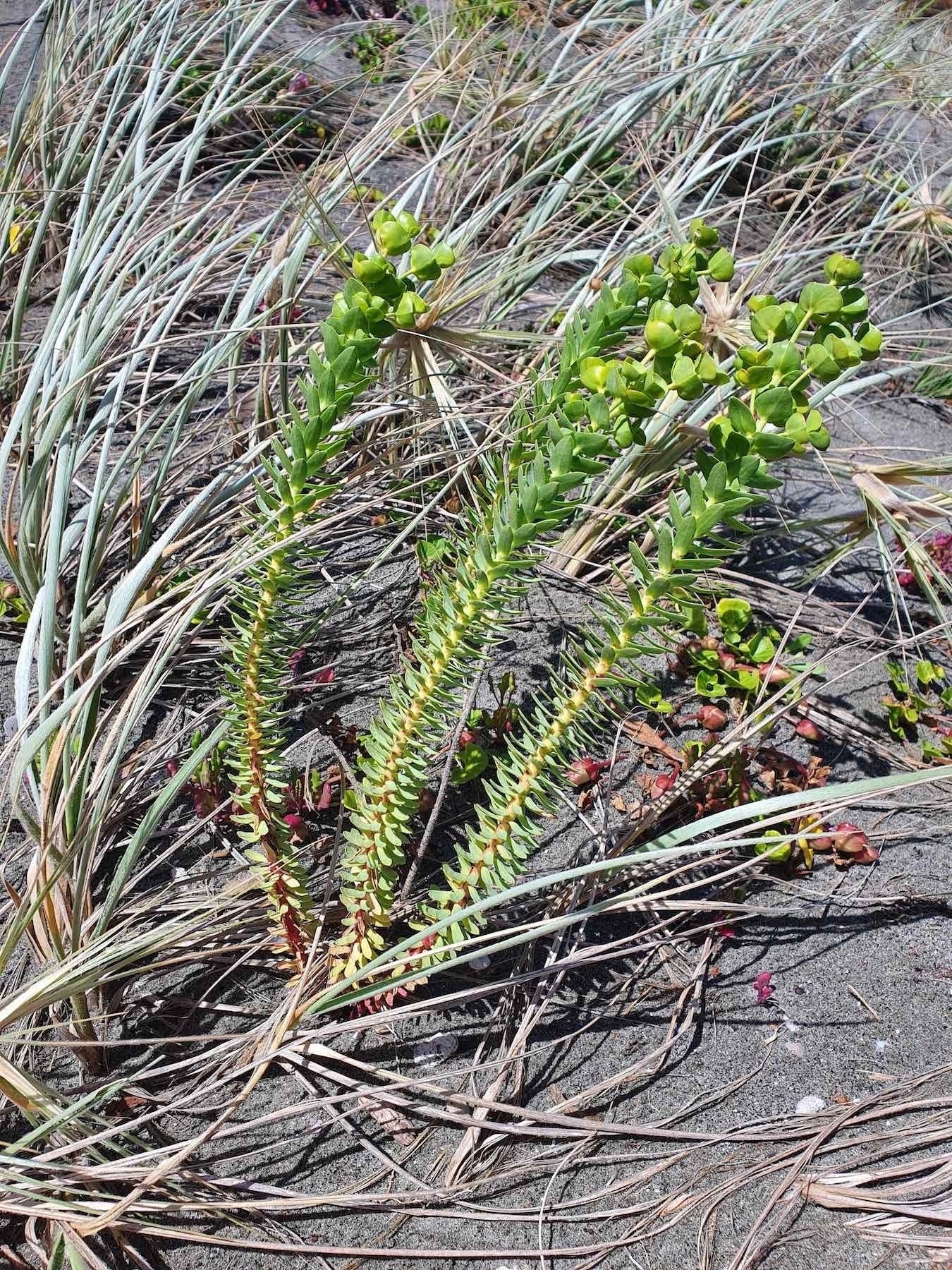
In 2021 a dangerous plant called Sea Spurge was found at Waikawa Beach in the dunes north of the river. It has established in an area 10 metres by 10 metres.
Do not touch this plant as it is toxic.

Sea spurge is a pest plant we have recently found in the dunes at Waikawa Beach. We know it is in four other locations along the Horizons region coastline. We need your help to track down any other sites across our region. Sea spurge can quickly out-compete other plants that protect our sand dunes.
⚠️ What’s more, its sap is harmful to both people and animals – causing skin irritation and even temporary blindness.
📞 If you think you’ve found sea spurge, do not try to remove it. Instead, call Biosecurity New Zealand on 0800 80 99 66 to report it. For more information head to www.biosecurity.govt.nz/seaspurge
The plants have not been removed, or marked off, as authorities want to study them and do not want to attract attention to them. They are inspecting the area regularly and monitoring closely.
Sea Spurge info
Sea spurge (Euphorbia paralias) is a potentially serious coastal environmental weed. It is native to western and southern Europe and is now well established along the Australian coastline. Seeds can survive up to six years in sea water and up to about 15 years in ideal conditions on land.
The pest plant poses a serious threat to the ecological and physical structure of sand dunes. If it establishes here, sea spurge could overrun many native dune species including spinifex, pingao and a number of sea grasses. It could also threaten the habitats of native birds such as dotterel and terns.
Members of the public are encouraged to report any suspected sightings as soon as possible because early detection offers the greatest chance of getting rid of this weed.
If you think you’ve found sea spurge, please contact Biosecurity New Zealand’s pest and disease hotline 0800 80 99 66. They will tell you what to do.
Please do not disturb the plants as moving them could spread seeds, and breaking stems releases the milky sap which is toxic and can cause skin and eye irritations.
Also, sea spurge looks very similar to the threatened native species Euphorbia glauca and the New Zealand linen flax, Linum monogynum, and we don’t want these accidentally removed. Ideally, take a photo and note the location as accurately as possible – GPS coordinates are ideal.
What it looks like
Sea spurge plants can grow in dense clusters or as individual plants up to one metre tall. Plants have multiple stems that are often reddish in colour at the base. The blue/green leaves are spiky, tightly packed and about 4-20mm long and 1-16mm wide. Green flowers bloom at the stem tips, mostly during the warmer months, and the flower stems die off each year after flowering.
Please look out for this plant as you go about Waikawa Beach. If you see any don't touch but do note its location, take a photo if possible and contact the Hotline above.

More info
Sea spurge
A serious threat to New Zealand’s beaches
The coastal weed sea spurge, Euphorbia paralias, was found at a beach near Aotea Harbour in the Waikato in 2012, and a single plant was detected at Mokau on the North Island’s west coast in 2019. This invasive weed would seriously impact our coastal environments if it became established. It is likely to have arrived on ocean currents from Australia.
Sea spurge infestations have caused major environmental problems at many Australian beaches by displacing native plants and changing natural patterns of sand movement.
What we are doing
Biosecurity New Zealand, the Department of Conservation, Waikato Regional Council and Taranaki Regional Council are working together on an eradication programme to stop sea spurge from establishing in those regions. The programme is focused on early detection so that plants are removed before they have time to produce seed. Activities include site management and annual survey of the coastline near Aotea Harbour.
How you can help
We need to find out if sea spurge is growing at other beaches, so let Biosecurity New Zealand know if you find any of the plants by calling the pest and disease hotline – 0800 80 99 66.
Early detection and reporting will help prevent sea spurge from establishing here.
Please don’t disturb the plants, as this could spread the seeds. Take a photo if you can and note the location as accurately as possible – GPS co-ordinates are ideal. Sea spurge has toxic sap, so be careful it doesn’t get on your skin.
What to look out for
Sea spurge is a hardy European shrub that thrives in coastal areas.
It has multiple stems that are often reddish at the base, and its spiky, tightly-packed blue/green leaves are 4–20mm long and 1–16mm wide. Green flowers bloom at the stem tips from September to May and the flower stems die off each year. The milky sap that oozes from broken stems is toxic to people and animals. The plants grow to about one metre tall in dense clusters overseas. Plants found in New Zealand were up to about 40 cm tall.
Sea spurge could establish almost anywhere along the New Zealand coastline. It looks similar to the rare native shore spurge, Euphorbia glauca, and New Zealand linen flax, Linum monogynum. However, native shore spurge has reddish flowers and much larger leaves that are 30–80mm long, while the stems of New Zealand linen flax are not reddish at the base. The New Zealand Plant Conservation Network website has photos of all these plants.
Biosecurity New Zealand, exotic pest and disease line 0800 80 99 66